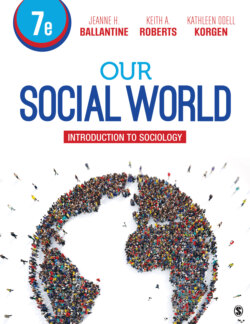Читать книгу Our Social World - Kathleen Odell Korgen - Страница 112
На сайте Литреса книга снята с продажи.
Evolution of Societies
ОглавлениеThe Saharan desert life for the Tuareg tribe is pretty much as it has been for centuries. In simple traditional societies, individuals are assigned to comparatively few social positions or statuses. Today, however, few societies are isolated from global impact. Even the Tuareg are called on to escort adventurous tourists through the desert for a currency new to them and unneeded until recently. In such traditional societies, men teach their sons everything they need to know, for all men do much the same jobs, depending on where they live: hunting, fishing, or farming and protecting the community from danger. Likewise, girls learn their jobs—such as childcare, fetching water, food preparation, farming, weaving, and perhaps house building—from their mothers. In contrast, in more complex societies, such as industrial or “modern” societies, thousands of interdependent job statuses are based on complex divisions of labor with designated tasks.
Émile Durkheim ([1893] 1947), an early French sociologist, pictured a continuum between simple and complex societies. He described simple premodern societies as held together by mechanical solidarity—social cohesion and integration based on the similarity of individuals in the group, including shared beliefs, values, and emotional ties between members of the group. Furthermore, the division of labor is based largely on male/female distinctions and age groupings; everyone fulfills his or her expected social positions. This provides the glue that holds the society together. The entire society may involve only a few hundred people, with no meso-level institutions, organizations, or subcultures. Prior to the emergence of nation-states, there was no macro level either—only tribal groupings.
According to Durkheim, as societies transformed, they became more complex through increasingly multifaceted divisions of labor and changes in the ways people carried out necessary tasks for survival ([1893] 1947). Organic solidarity refers to social cohesion (glue) based on division of labor, with each member playing a highly specialized role in the society and each person being dependent on others due to interdependent, interrelated tasks. The society has cohesion regardless of whether people have common values and shared outlooks. Prior to the factory system, for example, individual cobblers made shoes to order. With the Industrial Revolution, factories took over the process, with many individuals carrying out interdependent tasks. The division of labor is critical because it leads to new forms of social cohesion based on interdependence, and much less on familial and emotional ties. Gradual changes from mechanical (traditional) to organic (modern) society also involve harnessing new forms of energy and finding more efficient ways to use them (Nolan and Lenski 2014). For example, the use of steam engines and coal for fuel triggered the Industrial Revolution, leading to the development of industrial societies.
As societies changed toward organic solidarity, they added large organizations and institutions. The meso level—institutions and large bureaucratic organizations—became more influential for individuals and families. Still, as recently as 200 years ago, even large societies had little global interdependence, and life for the typical citizen was influenced mostly by events at the micro and meso levels. As communication and transportation around the world developed and expanded, the global level grew.
As you read about each of the following types of societies, from the simplest to the most complex, notice the presence of these variables: (a) division of labor, (b) interdependence of people’s positions, (c) increasingly advanced technologies, and (d) new forms and uses of energy. Although none of these variables alone is sufficient to trigger evolution to a new type of society, they may all be necessary for a transition to occur.
According to Durkheim, then, in traditional societies with mechanical solidarity, interpersonal interaction and community life at the micro level were the most important aspects of social life. Meso- and macro-level societies developed as a result of changes toward more organic solidarity. As societies become more complex, meso- and macro-level institutions evolve and become more important, and have increasingly profound impacts on the lives of individuals.
